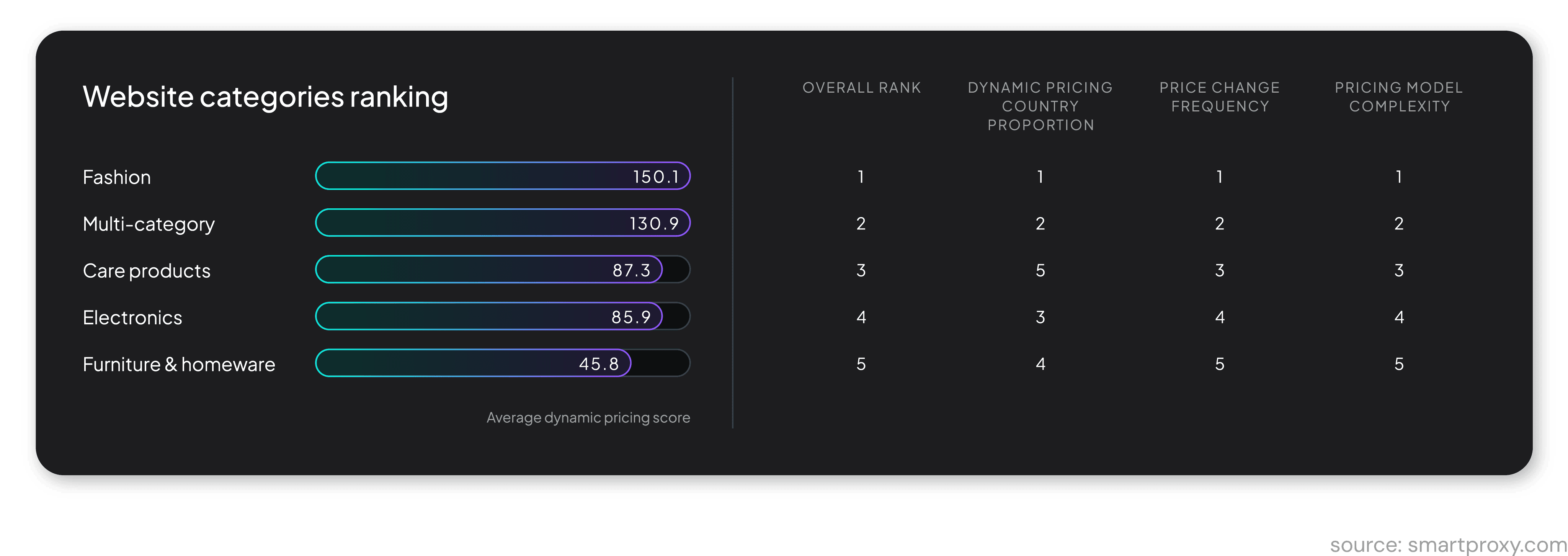Dynamic Pricing Index: Fashion Takes the Lead
In our comprehensive eCommerce Dynamic Pricing Index, we delved into the prevalence, frequency, and complexity of dynamic pricing techniques across various product categories. Our analysis reveals fascinating insights, particularly highlighting the fashion sector as a frontrunner in the use of advanced dynamic pricing strategies.
The eCommerce Dynamic Pricing Index
The eCommerce Dynamic Pricing Index evaluates websites based on 3 main criteria. These criteria were chosen because they offer a robust framework for evaluating the dynamic pricing proficiency of eCommerce websites.
- Dynamic pricing country proportion indicates the extent to which dynamic pricing is utilized across different regions, showcasing how widespread these strategies are.
- Price change frequency measures how often prices are adjusted, indicating the eCommerce site’s ability to stay competitive in a fast-paced environment.
- Pricing model complexity reflects the sophistication of the pricing algorithms used, showing the platform’s capability to leverage advanced data analytics and forecasting techniques to optimize pricing.
The included product categories
Our study encompassed a variety of product categories to provide a comprehensive view of the eCommerce landscape. The categories analyzed were represented by major and minor marketplaces, including well-known names in retail and online shopping platforms like Walmart, Amazon, Wayfair, Best Buy, Rakuten, IKEA, Zalando, and many others. The 5 categories analyzed were:
- Multi-category – this includes websites that typically function as large online marketplaces. They offer a wide range of products spanning various categories, such as electronics, fashion, home goods, beauty products, and more.
- Care products – this category comprises items related to personal care and wellness, such as skincare, haircare, cosmetics, hygiene products, and health supplements.
- Electronics – this includes consumer electronics such as smartphones, laptops, tablets, home appliances, audio and video equipment, and other tech gadgets.
- Fashion – the fashion category encompasses clothing, footwear, accessories, and jewelry for men, women, and children. This segment includes a wide range of retailers from fast fashion to luxury brands and online fashion platforms.
- Furniture & homeware – this category features products for home furnishing and décor, including furniture, kitchenware, bedding, lighting, and home improvement tools.
Fashion leads the way in dynamic pricing

According to the data, eCommerce websites in the fashion category achieve the highest average dynamic pricing score, a remarkable 150.1 (with the average score represented by 100).
This score is a testament to their leadership in all 3 evaluated criteria: there’s widespread adoption of dynamic pricing techniques across various regions, the highest frequency of price adjustments, and the most sophisticated pricing algorithms.
Following fashion, multi-category eCommerce websites secure the second position with a dynamic pricing score of 130.9. These sites also perform admirably across all criteria, although not quite matching the fashion sector’s dynamism.
Underperforming categories: care products, electronics, and furniture & hardware
Now let’s look at the categories that scored below average based on our Dynamic Pricing Index. The care products sector, with an average dynamic pricing score that is less than half behind fashion, 87.3, showcases a significant gap in dynamic pricing strategy.
Electronics, with a score of 85.9, ranks fourth, just behind care products. Despite their edge in dynamic pricing country proportion, they lag behind in the frequency of price changes and complexity of pricing models compared to the leading categories.
At the lower end of the spectrum, furniture and homeware eCommerce websites score 45.8, the lowest in our index. These sites show minimal engagement in dynamic pricing, reflected in their low frequency of price changes and simplistic pricing models.
Final thoughts
Our study shows that dynamic pricing is more prevalent in fast-moving consumer goods (FMCG) sectors where frequent price fluctuations are driven by the low cost and minimal maintenance of such products. In contrast, industries like furniture, homeware, and electronics face higher production costs, making constant price adjustments challenging. This is why these sectors are slower to adopt dynamic pricing. Meanwhile, the fashion industry thrives on dynamic pricing strategies to stay ahead in its rapidly changing market.
Explore how various eCommerce platforms leverage user experience for better conversion. Continue learning with eCommerce Maturity Index.
About the author

Dominykas Niaura
Technical Copywriter
Dominykas brings a unique blend of philosophical insight and technical expertise to his writing. Starting his career as a film critic and music industry copywriter, he's now an expert in making complex proxy and web scraping concepts accessible to everyone.
Connect with Dominykas via LinkedIn
All information on Smartproxy Blog is provided on an as is basis and for informational purposes only. We make no representation and disclaim all liability with respect to your use of any information contained on Smartproxy Blog or any third-party websites that may belinked therein.







